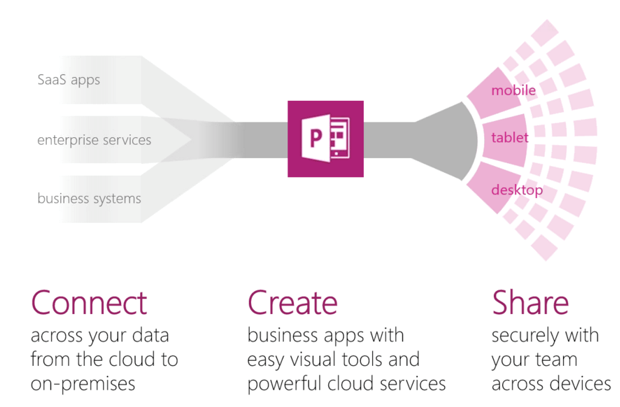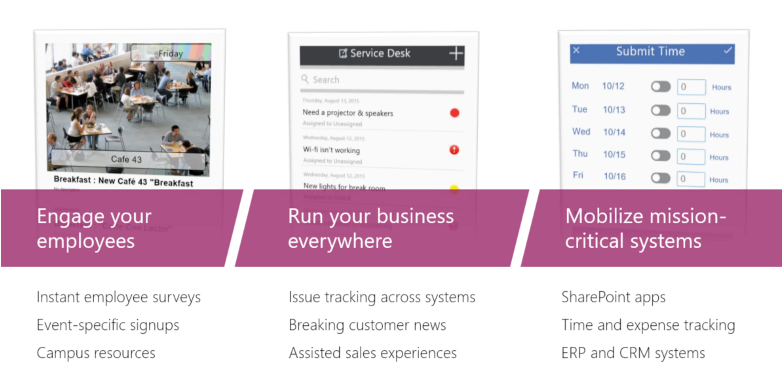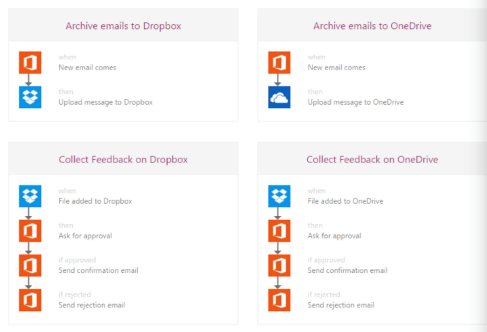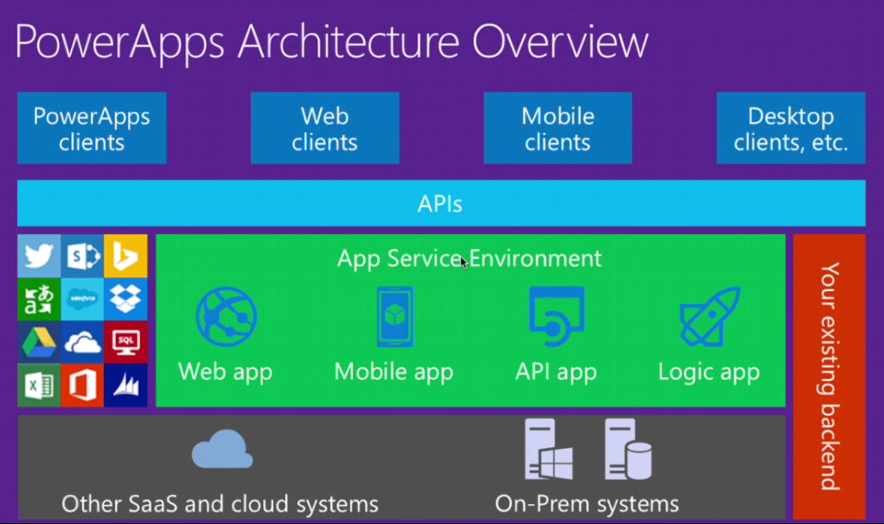This post provides a high-level overview of Microsoft PowerApps and its likely future influence on collaborative applications, with emphasis on how PowerApps is poised to become a powerful and popular option for enterprises migrating to Office 365 from traditional on-premises content/collaboration platforms such as SharePoint or Notes/Domino. Future CASAHL blog posts in this series will deep-dive on PowerApps details and provide more information about how PowerApps can address longstanding enterprise collaborative application challenges.
A Brief PowerApps Introduction
Microsoft PowerApps was introduced at the end of November 2015. PowerApps Principal Program Manager Bradley Millington, during a recent Office 365 Pulse presentation, described PowerApps as “an enterprise software service for innovators everywhere to connect, create, and share business apps.” He shared this PowerApps big-picture diagram during the same presentation:
The initial focus for PowerApps includes mobile apps (on Android, iOS, and Windows mobile devices) created and shared by business users who are familiar with Office-based development concepts such as the Excel formula language. Although desktop (e.g., Windows or Mac OS browser client) support is not included in the PowerApps limited beta, Microsoft has indicated it will be added in a future update. PowerApps apps are built in HTML5, JavaScript, and JSON, with an open architecture that can be extended to address a wide variety of device types, data sources, and service providers.
PowerApps is not intended for professional application developers (e.g., programmers working with Visual Studio or Eclipse). Developers working with those tools can easily create API services that can be made accessible to PowerApps developers, however, to make enterprise business actions or data services securely available to PowerApps developers. The PowerApps value proposition for professional developers, in other words, is to empower business users to directly address a range of app needs on their own, building on IT-provided and managed services, thus making it possible for professional developers to focus their attention on more complex enterprise app projects.
Sample application domains referenced during the Office 365 Pulse presentation included:
PowerApps users creating new apps are presented with three options: start from a template, start from your data, and start from scratch. Templates included with the limited beta release include budget tracker, conference agenda, contacts, event signup, instruction manual, opportunity tracking, product catalog, service desk, and survey. Each app template includes multiple cards (forms) for viewing and updating content, along with Excel workbook-based sample data. PowerApps also provides a variety of layout and theme options for app customization. During the Office 365 Pulse webinar, Bradley Millington mentioned there were initially nine app templates (with the limited beta), with six more to be added that week, and plans to eventually make hundreds of app templates available.
To create a new PowerApps app from an existing data source, users specify a data connection (source) type and table. PowerApps supports a wide variety of data sources including Excel workbooks (e.g., stored on Dropbox or OneDrive), SharePoint lists, SQL Server, other database management systems/services, and a variety of software-as-a-service sources such as Microsoft Dynamics CRM and Salesforce.com. PowerApps automatically creates multiple cards for the specified data source, for viewing list collections, viewing single records, and inserting or updating records.
There probably aren’t many app scenarios for which it’s more efficient to start from scratch, with a blank PowerApps app canvas, rather than starting with an app template or from an existing data source.
PowerApps also includes a large collection of logic flow templates, making it possible to create non-trivial mobile apps without programming. A snapshot of some of the logic flow templates referenced during the recent Office 365 Pulse presentation:
Other logic flow templates referenced during the presentation included:
-
Create leads in Salesforce from received emails
-
Get approval on email
-
Get daily reminders in email
-
Get email notifications for tweets
-
Order lunch for Salesforce meeting
-
SharePoint document changed
-
SharePoint item added
PowerApps, in a limited beta phase during December 2015 and expected to be more broadly available during early 2016, may seem audaciously ambitious, but it builds on well-established market dynamics including popular consumer Internet-focused end user application development tools/services such as IFTTT (If This Then That), which uses application templates (known as recipes) and a simple form-driven model to create apps involving the integration of multiple tools and services (e.g., to monitor Twitter for a particular topic and send an email alert or post a new note in a shared OneNote notebook when related tweets are published). Zapier is a similar tool/service, targeted more at business organizations than individual consumers.
PowerApps also builds on Microsoft’s Azure App Service platform. The following diagram, from an MSDN overview titled Native Enterprise Apps with PowerApps, provides an overview of how PowerApps fits into the broader Azure platform:
Although PowerApps is a new tool/service offering, it’s important to understand that it builds on a well-established Azure foundation, using the same services, for example, that have been successfully leveraged in Azure Web apps during the last several years.
Due to its deep dependencies on Azure infrastructure services, it’s unlikely PowerApps will be available with an on-premises option. Apps created with PowerApps can integrate with on-premises data sources and applications, however, again relying on Azure infrastructure services for identity, authentication, authorization, and other requirements. You can find more PowerApps-related information at the PowerApps site, including an overview of PowerApps pricing/licensing plans.
Overall, PowerApps is closely aligned with Microsoft’s overall corporate strategy, being “mobile-first” (but not exclusively focused on mobile devices) and “cloud-first,” and making the power of the Azure and Office 365 cloud platforms accessible to business users.
How PowerApps Will Likely Influence Future Collaborative Apps
Although not specifically focused on collaborative apps, e.g., common workflow scenarios that were in the past addressed by tools such as InfoPath used in conjunction with SharePoint, PowerApps is likely to have a big influence on future collaborative application planning. By making the power of the Azure App Service Environment readily and securely available to non-professional developers through a large collection of app and app logic flow templates, and by starting with a focus on apps for mobile devices, PowerApps addresses a large and growing market need that hadn’t been successfully addressed by earlier tools and services.
Many of the most complex types of apps created with on-premises content/collaboration platforms such as traditional SharePoint and Notes/Domino will be simpler to address with PowerApps, in part because of its scope and simplicity and in part because many of the sharing and other collaborative activities addressed by legacy content/collaboration platforms are now built into the leading device platforms. As with other recent Microsoft tool/service introductions such as Delve and Power BI, PowerApps can amplify the business value of enterprise information resources, but only once those resources are migrated to modern content and database management services in the Azure and Office 365 platforms.
CASAHL DART strongly complements PowerApps by making it easy for enterprises to assess and migrate content/collaboration resources from a wide variety of source system types to multiple Azure and Office 365 target tools/services. DART can be used to automatically disaggregate and recompose complex legacy collaborative apps created in traditional SharePoint or Notes/Domino, for example, revitalizing enterprise content resources and making them readily and securely accessible through PowerApps.
A typical complex legacy SharePoint or Notes app is likely to include a mix of documents, data (structured lists), conversations, and business logic expressed in workflow actions. DART makes it possible to automatically disaggregate and migrate the application elements to the most appropriate tool/service in Office 365. A legacy collaborative app migration mapping can include, for example:
-
Documents migrated to OneDrive for Business or SharePoint document libraries
-
Data migrated to a wide variety of structured data managers, including SharePoint (SharePoint lists), SQL Server, and Azure SQL Database
-
Conversations migrated to Office 365 Groups or SharePoint discussions
-
Business logic recomposed in several tools, including the new PowerApps logic flows
DART also automatically handles all related metadata and access control mapping and migration.
Future CASAHL blog posts in this series will explore other facets of the new and compelling collaborative application capabilities provided by Microsoft PowerApps.





